OSCON & OpenSource World 2009 Double Report
In this its eleventh year, OSCON moved from Portland, Oregon -- where it has been traditionally held -- to the San Jose McEnery Convention Center, where the exhibition was held for two days, on July 22 and 23. I live in Tracy, which is about 60 miles (approx. 100 km) east of San Jose; the drive would take about one hour in light traffic, but since I would have had to leave the house at morning peak hours, I decided that I was not going to drive this time; instead, I planned on taking the Altamont Commuter Express train (ACE for short), which goes from Stockton (further east of Tracy) and San Jose in the Bay Area. Since some of the Haiku booth gear is sitting around in my garage, Urias was kind enough to stop by my house on the way to San Jose the night before, and pickup all the stuff so that the next morning I could travel light (thanks Urias!). So, the next morning I took the ACE train a little after 6:00AM, and enjoyed the ride: I did some reading, dozed a bit for a while, and even engaged in a nice conversation about soccer with a Portuguese guy sitting in front of me. Once I arrived at the San Jose terminal, at around 7:45AM, Scott was waiting for me and from there we headed to the convention center, which was just a few miles away.
Upon arrival on site, we picked up our exhibitor badges (and met the very supportive May Carver, of IDG) and contacted Urias who, as it turned out, was already on the exhibit floor. Setting up our booth was fairly easy (we have done it so many times now!), and we were ready with our usual setup in short order. This time we had Scott's notebook, Urias' netbook (an Acer Aspire One) and my small Shuttle K45 hooked to our projector, with the big projector screen hanging on the booth backwall.
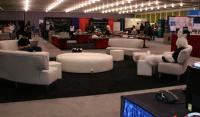 View of the spacious OSCON exhibit floor from the Haiku booth.
View of the spacious OSCON exhibit floor from the Haiku booth.The OSCON exhibit floor was fairly big and quite spacious. Our booth was located all the way to the back, on the left-hand side of the floor, right in front of a lounge area with nice couches where people could rest their tired feet and backs; you can see the exhibit floor plan (138KB PDF). Location was not particularly good or bad, but given thanks to the open space that the lounge area provided in front of us, I think we were quite visible from many areas of the exhibit. Our live running demo of Haiku on the big projector screen is always quite eye-catching, so it was hard to miss us.
During the show, we had the company and assistance of Pete Goodeve, a known community member from San Francisco, who hung out with us and helped at the booth throughout the show. Thanks Pete! We also enjoyed a brief but always very much treasured visit from Travis Geiselbrecht (of NewOS fame, from which the Haiku kernel was originally based on), as well as that of Kurt von Finck, who at one point worked for Gobe Software in the development of the Gobe Productive office suite. Interestingly, people from Microsoft as well as Canonical visited our booth in various occasions throughout the event, and showed keen interest in the development of Haiku. It looks like we are gradually becoming something real to these folks too. :)
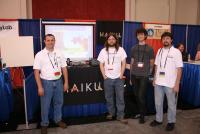 Urias McCullough, Travis Geiselbrecht, Evan, and Scott McCreary at OSCON.
Urias McCullough, Travis Geiselbrecht, Evan, and Scott McCreary at OSCON.LINUX PRO Magazine is a publication that has a frequent presence in open source conferences like OSCON. I had met several times with their then Managing Editor and now Associate Publisher Rikki Kite. Every time, we had discussed Haiku coverage on their magazine (which we did get on their LUGRadio San Francisco editorial in 2008), but for one reason or another it has not materialized in the form of an in-depth article (which is what I would like to see). At OSCON, Rikki was kind enough to connect us with Editor-in-Chief Joe Casad, who spent some time at our booth and was given a quite thorough demo by Urias. Well, he was very pleased with what he saw (by his own words), so don't be surprised if you see Haiku being covered in their publication in the coming months. I actually met with Rikki at OpenSource World last week, and we talked about following up after the alpha release to make sure that this happens.
Other interesting folks stopping by the Haiku booth also included Bill Hoffman from Kitware, developers of Cmake; Bill Kendrick from LUGOD, developer of TuxPaint, who even did a some quick debugging of the Haiku port of his application on Urias' netbook (see photo); and David Maxwell from Coverity, who discussed with Urias how to get their code analysis tool running (again) with Haiku. Technology analyst Kaz Miyamoto of Venture Clef was so impressed with Haiku, that he pledged to write an article about it, and he actually did; here you can find the article written in Japanese (Google translate should give you a gist of what he wrote). Finally, I also want to note that I met with Kieran Lal, product manager at Acquia, the business arm of Drupal, who gave me some leads on how to deal with our upcoming website upgrade to Drupal 6.
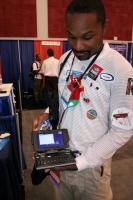 Bryan posing with his little device running Haiku.
Bryan posing with his little device running Haiku.I think it was on the second day that Bryan Smith from the Florida Linux Show stopped by our booth with a little Fujitsu Lifebook U810 "sub-netbook" device. Urias Scott could not resist the temptation, so he tried booting Haiku on this neat little device off one of the USB sticks, and well, it just worked. :) We well all pretty amazed at how fast Haiku was, and should have seen Bryan's excitement. On the photo to the left you can see Bryan posing with the Lifebook U810 (which belonged to a friend, by the way), and here is a short video of the little device running Haiku. By the way, the Florida Linux Show 2009 will take place on October 24, 2009 at the beautiful Radisson Resort Orlando-Celebration, located very close to the Orlando Walt Disney World Theme Parks. If anyone is interested in the Florida Linux Show, check out their website.
Booth traffic was pretty consistent throughout the two days of the show, to the point where the three of us were quite busy most of the time. Another nice aspect of OSCON was the almost constant supply of drinks and food that were available for free throughout the day, including lunch and dinner, snacks in between, and even booze at the evening reception that held the first day (I don't drink, but I know many appreciate that). Service from O'Reilly both before and during the show was simply outstanding; our special thanks go to May Carver, who was incredibly responsive all the time, and made it a real pleasure to be part of this conference. All in all, OSCON was a great show, and we definitely want to do it again in the future; word is that it is here to stay in the Bay Area, so OSCON 2010 is definitely in my list of don't-want-to-miss events.
OpenSource World: A bag of mixed emotions
While OSCON was an unequivocally good show, OpenSource World (formerly LinuxWorld) was more of a mixed bag. Early this year, we were very disappointed to hear from IDG show management that there was not going to be a free .Org area like they always had been in the past. Projects like ours were offered a discount for a full-fledged (10x10 foot) booth, but the price was prohibitive. We let IDG know of our displeasure with their “focus shift” away from supporting the open source community, and decided to move on. To our surprise, some time later I received an email from IDG saying that they had changed their mind, that there would be a .Org zone, and that we would be welcome to apply. Apply we did, and to our rejoice, the application was accepted! Unfortunately, the turbulent jet-coaster ride with IDG did not end there: later on, we realized that what we were getting was not a booth, but a table in a room segregated from the exhibit area. On top of that, you could not just get an admission to the exhibits; you had to apply for it, and the application could be denied on the grounds of some obscure criteria that only IDG knows. I know, because it happened to me: the .Org zone exhibitors were only assigned two exhibitor badges, so while we requested a third one (which IDG eventually granted us), I applied for a regular admission just in case; this is what I received the next day from IDG:
We regret to inform you that your registration for the OpenSource World/Next Generation Data Center/CloudWorld conference, managed by IDG World Expo, has been denied. This year's event requires that all attendees meet certain qualifying criteria to be admitted to the show. Unfortunately, your professional profile does not meet the qualifying criteria.
Ouch! Don't get me wrong: I appreciate the opportunity to have a free exhibit space; but how can you call yourself OpenSource World and then segregate the open source communities in such a way? What does this say about the event and the people running it? Apparently, we were not the only ones displeased with this, and many viewed the direction in which IDG took this event as an unwise move and probably the beginning of the end for this conference. If you consider the substantially diminished number of exhibitors and general attendance when compared to last year's LinuxWorld, as well as the common negative opinions expressed by many people attending the event, those predictions may turn out to be right. Time will tell.
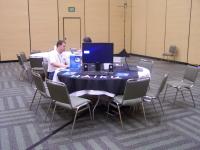 Haiku table at OpenSource World .Org Zone
Haiku table at OpenSource World .Org ZoneBut, how was OpenSource World after all? Well, in spite of the bad taste that we went into the conference with, and the reduced exhibit times (noon to 1:30PM and 4:30 to 6:30PM), showing Haiku and seeing people react positively to it always gives you a good warm feeling. :) Being in the “segregated room” (as I called it) did obviously have an impact on our visibility; the room was all the way in the back of the exhibit floor, behind a small door that was not particularly obvious, so unless you came really close to it, it was very easy to miss. But still, we got a decent dose of interesting visitors. Our setup had to be different this time (see photo to the right), so while we did not have the big projector screen like we usually do, Urias brought with him a nice and big flat screen which we positioned facing the entrance door in order to capture the sight of those coming into the room. The round table actually worked well, as we could be doing two or three demos on different sides of the table without interfering with each other.
Worth noting was the visit of Michael Dexter, Program Director of the Linux Fund. Michael watched and listened with keen interest throughout our demo of Haiku and finally gave us some advise on how we could potentially receive funding from the Linux Fund. He basically suggested that a killer – perhaps an appliance-like – application would be the most likely case where funding could be procured. So, if there is coders out there with any crazy Haiku application ideas that they would like to get funding for, contact us and we will help you pursue potential funding.
On both days we had the company of Jack Small, one of the developers of Marten, an integrated development environment for MacOS X developed by a company called Andescotia Software. Marten is a graphical programming tool that is, if I understood Jack correctly (which may not be the case), well suited for but not limited to rapid application development. The reason Jack came to see us was that they are entertaining the possibility of adding support for Haiku to Marten, which would be really interesting. Jack was so impressed with Haiku, that he went ahead and recently bought an Atom 330 (dual core + HyperThreading) machine specifically for Haiku development; last I heard, a couple of days ago, he is totally impressed with the performance he is getting from this under us$300 piece of hardware; no wonder, coming from the overpriced Mac world... :)
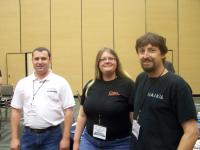 Urias, Leslie Hawthorn and Scott posing in front of the Haiku table.
Urias, Leslie Hawthorn and Scott posing in front of the Haiku table.We were also very pleased to have Leslie Hawthorn, program manager for Google's Open Source Team and the person pretty much in charge of the Google Summer of Code, visit our table. Among other things, we briefly chatted with Leslie about this year's Google Summer of Code Summit, which will hopefully bring the presence of one or more Haiku mentors to the Bay Area, and the Haiku Code Drive (which Leslie is supportive of); at one point, she stood in front of Urias' netbook running Haiku and said: “Hey, I really like what I'm seeing here!” It is comments like this that make you forget all the negative aspects of this (or any) conference and make it all worthwhile to be there. :)
On the second day, I personally demoed Haiku to people from a Japanese company called SPark that does development in the embedded space. I met them while Urias and I were demoing Haiku at the Dell booth (more on that below), and they were so impressed with what they saw, that we went to our table for a more in-depth presentation. In the end, we exchanged cards and in fact we have stayed in contact after the show via email; in what one could call a strike of good luck, the JPBE.net guys (the Japanese BeOS/Haiku community) are planning Haiku workshops, so I suggested that they try to attend in order to learn more about Haiku and to make connections with the local community. Hopefully this will lead to new developments coming from Japan in the near future.
Also from Asia, we had a couple of people from DaouTech, a technology company in Korea which is apparently the distributor of RedHat (among other solutions). I did the usual Haiku demo to them and they were both very impressed, to the point where Mr. Kang-Il Lee, Manager of their OSS Department, offered his card and asked to stay in touch after the event as they would like to learn more about Haiku and potentially pursue introducing Haiku in Korea. Again, we'll see if anything transpires from this.
As I briefly mentioned in one of the above paragraphs, Urias and I went to the Dell booth in an attempt to demo Haiku on their hardware (they had a couple of netbooks and a laptop). At their booth, Dell had one big flat screen showing Ubuntu running a single (small) video; the amazing thing that I noticed was that the video was very choppy; "what a terrible way to show off your hardware!" I thought to myself when I saw that, so I asked one of the Dell guys at the booth if we could try out Haiku off a USB stick. “Sure,” he said. So later on we came back with Urias and booted Haiku off the laptop they had Ubuntu running on. You should have seen their faces when we played 5-6 videos simultaneously without dropping even a single frame! They were stunned! Before we knew it, the Dell booth was full of people looking at what we were doing, and asking about Haiku (that's how I met the guys from SPark). Of course, we took the opportunity to hand out Haiku fliers, including to the Dell guy who was asking us how he could try this on his own machine. ;) Urias and Scott did the same at the Fujitsu and Polywell booths.
I also met with Gareth Greenaway of the SCaLE Conference (who, by the way, introduced me to Jono Bacon, Ubuntu Community Manager at Canonical), and we spoke about SCaLE 7x, which has already been scheduled to be held on February 19th-21st, 2010 at the Westin LAX Hotel in Los Angeles. Needless to say, Haiku plans to be there; in fact, we may be up to something more than just a booth, but I will leave it at that for now. ;)
All in all, OpenSource World was not that bad. Personally, however, I am not really sure if I will want to do it again next year given the path that IDG has decided to take for this event. We'll see. Considering that OSCON 2010 that will most likely be held again in the Bay Area, I would probably prefer to focus our effort there.
Apologies again for the very late report; I hope you still enjoy it. Many thanks go to both Urias and Scott for their help in writing this article: they both refreshed my memory and helped fix my sometimes broken English. :)
Photos, Slideshows and Videos
- OSCON 2009 in San Jose: Photos | Slideshow
- OpenSource World 2009 in San Francisco: Photos | Slideshow
- Video: Haiku running on a Fujitsu Lifebook U810 (on YouTube, so Flash required)
koki's blog
- My Impressions from SCaLE 2010
- The History Channel: 2003 Interview with Michael Phipps
- What do You Know About the Haiku Logo?
- OSCON & OpenSource World 2009 Double Report
- Haiku Coming to OSCON 2009 in San Jose
- Testing CSS Styles from Haiku User Guide
- Haiku at SCaLE 2009: the Report
- LinuxWorld 2008 as I saw it
- Video: Code_Swarm for Haiku
- Haiku Code Drive: May 16 update




